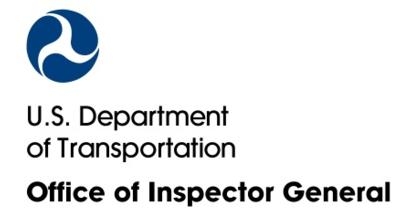Thu, Dec 08, 2016
Self-Initiated Audit Resulted In Six Recommendations To The Agency
Recognizing that the growing demand for civil Unmanned Aircraft Systems (UAS) operations presents new safety oversight challenges for the FAA, and given the significant and complex challenges of safely integrating UAS into the National Airspace System and the increasing number of UAS operations, the DOT Inspector General's office initiated an audit of FAA’s processes for approving civil UAS operations and overseeing the safe operation of UAS.

Using an authority granted by Congress, FAA has approved over 5,500 commercial UAS to operate by exempting them from regulatory requirements, and recently issued a final rule governing operations of small UAS.
In the audit, the IG found that FAA streamlined its process in 2015 for exempting civil UAS from regulatory requirements in response to increasing requests for exemptions and concerns over lengthy approval times. However, FAA’s process does not verify that operators actually meet or understand the conditions and limitations of their exemptions either before or after the application is approved. Furthermore, while FAA has taken some steps to advance UAS technology, the Agency has not established a risk-based safety oversight process for civil UAS operations—a key tool for focusing resources on a range of emerging risks. Despite an increase in reported UAS events, FAA lacks a robust data reporting and tracking system for UAS activity. As a result, FAA is currently taking a reactive approach to UAS oversight.
The IG's office recommended that the FAA do the following:
- Establish specific milestones to update and maintain UAS guidance to keep pace with technological developments and incorporate inspector feedback.
- Develop comprehensive and updated training for safety inspectors on UAS technologies and Agency rules and guidance related to UAS oversight.
- Initiate a periodic process to perform inspections of commercial UAS operators based on operational factors (e.g., location, number of operations, and type of activity) to verify knowledge of and compliance with FAA requirements and to inform the development of a risk-based oversight plan.
- Design and implement a risk-based and prioritized oversight plan for UAS to help ensure safe operations of UAS.
- Develop and implement a process to coordinate existing disparate UAS databases within FAA to facilitate data mining and safety analysis.
- Implement a process to share UAS data with field oversight offices to assist inspectors in risk-based and proactive oversight of civil UAS operations.
The IG said the FAA concurred with all six of its recommendations to enhance the effectiveness of FAA’s oversight of civil UAS. Based on FAA’s response, we consider two recommendations resolved but open, and we are requesting additional information for four recommendations.
(Source: DOT IG. Images from file)
More News
Aero Linx: Commercial Aviation Safety Team (CAST) Founded in 1997, the Commercial Aviation Safety Team (USCAST) has developed an integrated, data-driven strategy to reduce the comm>[...]
Land And Hold Short Operations Operations that include simultaneous takeoffs and landings and/or simultaneous landings when a landing aircraft is able and is instructed by the cont>[...]
We're Everywhere... Thanks To You! Even with the vast resources and incredibly far-reaching scope of the Aero-News Network, every now and then a story that should be reported on sl>[...]
Pilot’s Inadvertent Use Of The Landing Gear Control Handle Instead Of The Flaps Selector Switch During The Landing Rollout Analysis: The pilot reported that during the landin>[...]
Also: Cosmonaut Kicked Out, Airbus Scales Back, AF Silver Star, Russian A-60 Clobbered A Samaritan’s Purse humanitarian flight was hijacked on Tuesday, December 2, while atte>[...]
 ANN's Daily Aero-Linx (12.12.25)
ANN's Daily Aero-Linx (12.12.25) ANN's Daily Aero-Term (12.12.25): Land And Hold Short Operations
ANN's Daily Aero-Term (12.12.25): Land And Hold Short Operations ANN FAQ: How Do I Become A News Spy?
ANN FAQ: How Do I Become A News Spy? NTSB Final Report: Cirrus Design Corp SF50
NTSB Final Report: Cirrus Design Corp SF50 Airborne 12.08.25: Samaritans Purse Hijack, FAA Med Relief, China Rocket Fail
Airborne 12.08.25: Samaritans Purse Hijack, FAA Med Relief, China Rocket Fail



